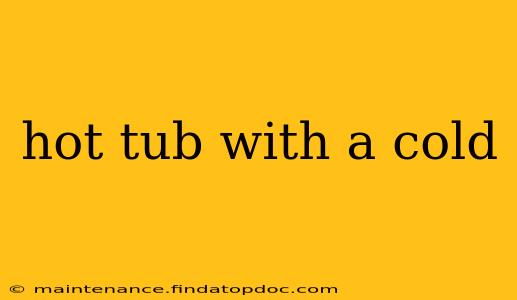Hot Tub with a Cold Plunge: The Ultimate Recovery and Wellness Experience
The combination of a hot tub and a cold plunge is rapidly gaining popularity as a powerful tool for recovery, relaxation, and overall well-being. This dynamic duo offers a unique blend of therapeutic benefits, exceeding what either experience provides individually. But what exactly are the benefits, and how do you best utilize this powerful combination? Let's dive in.
What are the benefits of a hot tub followed by a cold plunge?
This question lies at the heart of the matter. The benefits stem from the physiological responses your body undergoes during the contrasting temperatures. The hot tub session dilates your blood vessels, increasing blood flow and relaxing muscles. Following this with a cold plunge causes vasoconstriction, shrinking blood vessels. This cyclical process is believed to:
- Improve Circulation: The alternating vasoconstriction and vasodilation improve blood flow throughout the body, delivering oxygen and nutrients more effectively.
- Reduce Muscle Soreness and Inflammation: The heat helps soothe sore muscles, while the cold reduces inflammation and speeds up recovery. This is particularly beneficial for athletes and those with physically demanding jobs.
- Boost the Immune System: Studies suggest that cold exposure can stimulate the production of white blood cells, strengthening the immune system.
- Enhance Mental Clarity and Reduce Stress: The contrast of temperatures can have a profound impact on the nervous system, promoting relaxation and reducing stress and anxiety. The feeling of invigorating contrast often leads to an overall improved mood.
- Improve Sleep Quality: The relaxing effects of the hot tub combined with the invigorating cold plunge can contribute to a more restful night's sleep.
Is it safe to go from a hot tub to a cold plunge?
While generally safe for healthy individuals, it's crucial to proceed with caution. Listen to your body. If you have any underlying health conditions, such as heart problems or circulatory issues, consult your doctor before trying this combination. Start with shorter durations in both the hot tub and cold plunge, gradually increasing the time as you become more comfortable. Never jump into a cold plunge directly from a hot tub without taking a moment to adjust.
What is the ideal temperature for a hot tub and cold plunge?
The ideal temperature for a hot tub is typically between 100-104°F (38-40°C). For the cold plunge, the temperature range varies widely, depending on personal tolerance. Many people find a temperature between 35-50°F (2-10°C) to be effective.
How long should I spend in the hot tub and cold plunge?
This depends entirely on personal tolerance and preference. Begin with shorter sessions (e.g., 10-15 minutes in the hot tub followed by 1-2 minutes in the cold plunge). Gradually increase the duration as you become more comfortable, never exceeding your comfort level. Remember, it's about the contrast, not the duration.
What are the potential risks of hot tub and cold plunge?
While generally safe, potential risks include:
- Hyperthermia: Excessive heat exposure can lead to overheating. Stay hydrated and take breaks if needed.
- Hypothermia: Prolonged exposure to cold can lead to hypothermia. Monitor yourself closely and end the session if you start to feel overly chilled.
- Cardiovascular issues: Individuals with existing heart conditions should exercise extreme caution or avoid this practice entirely.
How often should I use a hot tub and cold plunge?
The frequency depends on your individual needs and goals. Some people find it beneficial to do this daily, while others may prefer a few times a week. Listen to your body and adjust accordingly.
By understanding the benefits, risks, and proper techniques, you can safely and effectively incorporate the hot tub and cold plunge into your wellness routine. Remember to always prioritize safety and listen to your body's signals. This dynamic combination may just be the key to unlocking a new level of relaxation and recovery.
